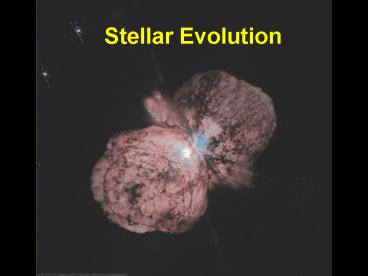Stellar Evolution - PowerPoint PPT Presentation
1 / 17
Title:
Stellar Evolution
Description:
Evolution off the Main Sequence: Expansion into a Red Giant. Hydrogen in the core completely converted ... Long-Period Varia-bility (LPV) Phase. Helium Flashes ... – PowerPoint PPT presentation
Number of Views:159
Avg rating:3.0/5.0
Title: Stellar Evolution
1
Stellar Evolution
0
2
Evolution on the Main Sequence
0
Development of an isothermal core
dT/dr (3/4ac) (kr/T3) (Lr/4pr2)
MS evolution
Zero-Age Main Sequence (ZAMS)
Lr 0 gt T const.
3
Interior of a 1 M0 Star
0
XH (4.3 x 109 yr)
XH (9.2 x 109 yr)
1.0
L (9.2 x 109 yr)
0.8
L (4.3 x 109 yr)
T (4.3 x 109 yr)
0.6
T (4.3 x 109 yr)
0.4
0.2
0.8
0.2
0.4
0.6
1.0
Mass fraction (along r)
4
Evolution off the Main Sequence Expansion into a
Red Giant
0
Hydrogen in the core completely converted into He
? Hydrogen burning (i.e. fusion of H into He)
ceases in the core.
H burning continues in a shell around the core.
He Core H-burning shell produce more energy
than needed for pressure support
Helium Core
Expansion and cooling of the outer layers of the
star ? Red Giant
5
Red Giant Evolution (5 solar-mass star)
Long-Period Varia-bility (LPV) Phase
0
Schönberg-Chandrasekhar limit reached
Inactive C, O
x
3a process
Inactive He
Red Giant phase
1st dredge-up phase Surface composition altered
(3He enhanced) due to strong convection near
surface
6
Helium Flashes
0
- H-burning shell dumps He into He-burning shell
- He-flash (explosive feedback of 3a process
strong temperature dependence! due to heating
of He-burning shell) - Expansion and cooling of H-burning shell
- H-burning reduced
- Energy production in He-burning shell reduced
- H-shell re-contracts
- Renewed onset of H-burning
Period
1000 yr for 5 M0
105 yr for 0.6 M0
7
Summary of Post-Main-Sequence Evolution of Stars
0
Core collapses outer shells bounce off the hard
surface of the degenerate C,O core
Formation of a Planetary Nebula
C,O core becomes degenerate
Fusion stops at formation of C,O core.
M lt 4 Msun
Red dwarfs He burning never ignites
M lt 0.4 Msun
8
Mass Loss from Stars
0
Stars like our sun are constantly losing mass in
a stellar wind (? solar wind).
The more massive the star, the stronger its
stellar wind.
Far-infrared
WR 124
9
The Final Breaths of Sun-Like Stars Planetary
Nebulae
0
Remnants of stars with 1 a few Msun
Radii R 0.2 - 3 light years
Expanding at 10 20 km/s (? Doppler shifts)
Less than 10,000 years old
Have nothing to do with planets!
The Helix Nebula
10
The Formation of Planetary Nebulae
0
Two-stage process
Slow wind from a red giant blows away cool, outer
layers of the star
The Ring Nebula in Lyra
Fast wind from hot, inner layers of the star
overtakes the slow wind and excites it gt
Planetary Nebula
11
Planetary Nebulae
0
The Helix Nebula
The Ring Nebula
The Dumbbell Nebula
12
Planetary Nebulae
0
Often asymmetric, possibly due to
- Stellar rotation
- Magnetic fields
- Dust disks around the stars
The Butterfly Nebula
13
Fusion into Heavier Elements
0
Fusion into heavier elements than C, O
requires very high temperatures (gt 108 K) occurs
only in gt 8 M0 stars.
14
Summary of Post-Main-Sequence Evolution of Stars
0
Supernova
Fusion proceeds formation of Fe core.
Evolution of 4 - 8 Msun stars is still uncertain.
Mass loss in stellar winds may reduce them all to
lt 4 Msun stars.
M gt 8 Msun
Fusion stops at formation of C,O core.
M lt 4 Msun
Red dwarfs He burning never ignites
M lt 0.4 Msun
15
Evidence for Stellar Evolution HR Diagram of
the Star Cluster M 55
0
High-mass stars evolved onto the giant branch
Turn-off point
Low-mass stars still on the main sequence
16
Estimating the Age of a Cluster
0
The lower on the MS the turn-off point, the older
the cluster.
17
Stellar Populations
0
Population I Young stars (lt 2 Gyr) metal rich
(Z gt 0.03) located in open clusters in spiral
arms and disk
Population II Old stars (gt 10 Gyr) metal poor
(Z lt 0.03) located in the halo (globular
clusters) and nuclear bulge































